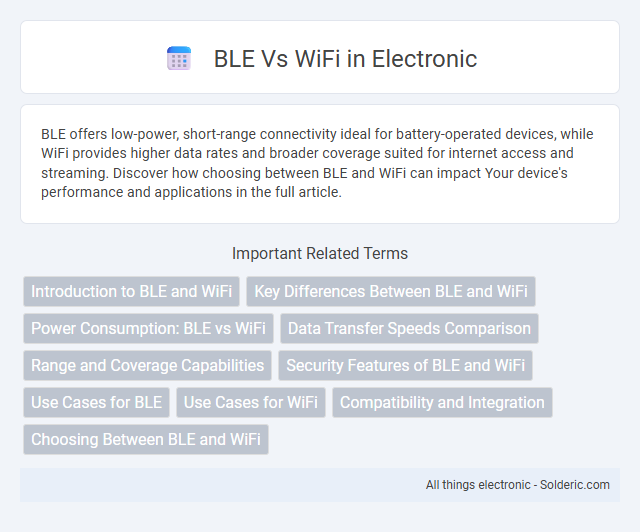BLE offers low-power, short-range connectivity ideal for battery-operated devices, while WiFi provides higher data rates and broader coverage suited for internet access and streaming. Discover how choosing between BLE and WiFi can impact Your device's performance and applications in the full article.
Comparison Table
| Feature | Bluetooth Low Energy (BLE) | WiFi |
|---|---|---|
| Purpose | Short-range, low power wireless communication | High-speed wireless internet and network access |
| Range | Up to 100 meters (depending on device class) | Up to 100 meters indoors, 300 meters outdoors |
| Power Consumption | Very low, optimized for battery-powered devices | Higher, requires more power due to higher data rates |
| Data Transfer Rate | Up to 2 Mbps (Bluetooth 5.0) | Up to several Gbps (WiFi 6/6E standards) |
| Typical Use Cases | Wearables, IoT sensors, health monitors | Internet access, streaming, large data transfer |
| Frequency Band | 2.4 GHz ISM band | 2.4 GHz and 5 GHz (up to 6 GHz with WiFi 6E) |
| Network Topology | Star, mesh (with BLE Mesh) | Star, infrastructure-based |
| Security | AES-128 encryption, pairing protocols | WPA3, AES encryption, enterprise-level security |
Introduction to BLE and WiFi
Bluetooth Low Energy (BLE) is a wireless communication technology designed for short-range, low-power applications, commonly used in wearable devices and IoT sensors. WiFi, on the other hand, provides high-speed internet connectivity over longer distances and supports data-intensive tasks such as streaming and large file transfers. Understanding the differences in range, power consumption, and data throughput between BLE and WiFi helps optimize Your choice for specific wireless communication needs.
Key Differences Between BLE and WiFi
BLE (Bluetooth Low Energy) specializes in low-power, short-range communication ideal for IoT devices and wearables, offering data rates up to 2 Mbps and typical ranges of 10-100 meters. WiFi provides higher data throughput ranging from 54 Mbps to several Gbps over longer distances, making it suitable for internet access and bandwidth-intensive applications. BLE excels in energy efficiency with minimal network complexity, while WiFi supports robust infrastructure, broader coverage, and compatibility with existing networks.
Power Consumption: BLE vs WiFi
Bluetooth Low Energy (BLE) consumes significantly less power than WiFi, making it ideal for battery-operated devices and prolonged use in IoT applications. BLE typically uses power in the range of microamps during idle states and low milliamps during data transmission, whereas WiFi demands considerably higher energy due to continuous radio operation and higher data throughput. This difference results in BLE enabling longer device lifespans and more efficient energy usage compared to WiFi, especially in scenarios requiring infrequent or low volume data exchanges.
Data Transfer Speeds Comparison
Bluetooth Low Energy (BLE) offers data transfer speeds typically up to 2 Mbps, making it ideal for low-power, short-range applications, while WiFi supports much higher speeds, often exceeding 1 Gbps with modern standards like WiFi 6. Your choice between BLE and WiFi depends on the required data throughput and device power consumption; BLE excels in energy efficiency with modest speed needs, whereas WiFi is suited for high-bandwidth tasks like streaming or large file transfers. Understanding these differences ensures optimal performance for your wireless communication needs.
Range and Coverage Capabilities
BLE (Bluetooth Low Energy) offers a shorter range typically up to 100 meters, making it ideal for close-proximity device communication with low power consumption. WiFi provides a significantly broader coverage area, often extending over several hundred meters, suitable for whole-home or office network connectivity requiring higher data throughput. Your choice between BLE and WiFi depends on the need for range versus power efficiency and data transfer speed.
Security Features of BLE and WiFi
Bluetooth Low Energy (BLE) employs AES-128 encryption with pairing mechanisms such as Just Works, Passkey Entry, and Numeric Comparison to safeguard data transmission, ensuring device authentication and privacy. WiFi utilizes WPA3 encryption standards, including SAE (Simultaneous Authentication of Equals) for enhanced protection against brute-force attacks and improved forward secrecy. Both BLE and WiFi implement robust security protocols, but WiFi's complex network architecture demands more comprehensive measures to prevent unauthorized access and data interception.
Use Cases for BLE
BLE (Bluetooth Low Energy) excels in use cases requiring low power consumption and short-range wireless communication, such as fitness trackers, smart home devices, and medical sensors. Its ability to maintain long battery life while enabling constant device connectivity makes it ideal for IoT applications and asset tracking. You benefit from BLE when designing systems that prioritize energy efficiency and intermittent data transmission within close proximity.
Use Cases for WiFi
WiFi excels in high-bandwidth applications such as video streaming, online gaming, and large file transfers, making it ideal for home and office environments. It supports multiple devices simultaneously with reliable internet access over extensive ranges, suitable for smart home systems and enterprise networks. WiFi's higher data rates and broader coverage enable seamless connectivity for cloud computing, video conferencing, and IoT devices requiring continuous internet access.
Compatibility and Integration
BLE (Bluetooth Low Energy) offers broad compatibility with most modern smartphones, tablets, and wearables, enabling seamless integration for low-power, short-range applications. WiFi provides extensive support across almost all internet-enabled devices, ensuring high-speed data transfer and connectivity over longer distances. Your choice between BLE and WiFi depends on the specific requirements for range, power consumption, and device interoperability in your network environment.
Choosing Between BLE and WiFi
Choosing between BLE and WiFi depends on your device's power consumption needs and data transfer requirements. BLE (Bluetooth Low Energy) excels in low-power applications with short-range communication, making it ideal for wearable devices and IoT sensors. WiFi offers higher data speeds and broader coverage, suitable for streaming and internet-based tasks.
BLE vs WiFi Infographic

 solderic.com
solderic.com